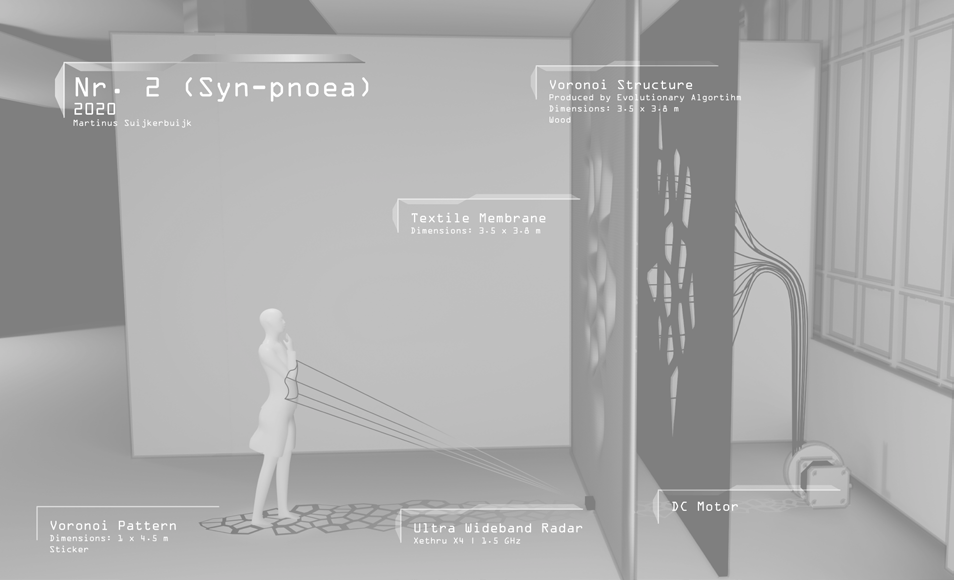SynPnoea Nr. 2 | Produced in cooperation with ZKM | Karlsruhe
Nr. 2 (Syn-pnoea) approaches the idea of an exhibition and environment as a living organism that reacts to the physical presence of its visitors and thus possesses a certain agency and autonomy. In this type of a new intelligent museum, which is designed as a responsive communication platform and also a dynamically modifiable space, a wall becomes an artwork. The project follows up on a previous installation of this kind by Martinus Suijkerbuijk, The Breathing Room (2018). Derived from Ancient Greek, the title Syn-pnoea means synchronized breathing. This immersive environment facilitates a dynamic interaction between an exhibition space and its visitors. The radar technology (XeThru X4 Ultra-Wideband (UWB) by Novelda) is a short-range impulse radar transceiver System on Chip (SoC) that is designed for human presence detection indoors and offers millimetric sensing precision to detect micromovements and activities through different materials – and therefore is able to detect the respiratory movements of the visitors. This radar has a range of up to 9 m and a bandwidth of up to 1.5 GHz. The movement data from the radar is translated by an algorithm to synchronize the movement of a linear actuator behind the “living” exhibition wall with the detected breathing rhythm of the visitors. The dark textile membrane that forms the “living” wall in the exhibition space has a stretching capacity and is pulled inward when an inhale-movement is detected, making the structure underneath the membrane more visible, and outward when an exhale-movement is detected. The installation enables participants to synchronize their breathing to the manipulation of the space, the wall becoming a giant living thorax. The pattern of the structure underneath the membrane was produced by an evolutionary algorithm. The basic principle of the algorithm is to construct Voronoi cells from a set of randomized seed points oriented around a space-attractor. Simply put, the Voronoi cell for each seed point is the area consisting of all the points that are closer to that seed point than to any other one. Voronoi diagrams are widely applied in many practical and theoretical fields, mainly in science and technology, from biology and computational chemistry to medical diagnosis and engineering. Nr. 2 (Syn-pnoea) is an installation that focuses on affective aspects of human-machine interaction. The use of radar technology in particular underlines potentials of future use of this technology. Radar originates in military research and is usually perceived as hazardous or even malicious. Here, it becomes a technology connecting our bodies to the environment. Text: Daria Mille
The Exhibition
Keywords:Mixed media installation, textile, Xethru Radar X4, linear actuator
The exhibition investigates different forms of artificial agents and environments, as well as their behavior and interactions with other entities within contemporary hybrid ecosystems. Some of these agents are purely digital, computer-generated and computer-simulated systems that evolve on a screen, while others include complex adaptive robots that have a physical presence in space and can manifest biomimesis as search mechanisms, swarm intelligence, self-preservation, and so on. Nevertheless, they imitate, demonstrate, and simulate life-like behavior by responding to stimuli in unpredictable ways. The artificial agents shown in this exhibition raise questions about self-sustaining nonorganic life by presenting their ability to interact with each other and with humans and nonhumans alike, as two-dimensional images, three-dimensional objects, and multidimensional quantum models. In this exhibition, we explore these dynamic systems at the intersection of art and science – both in terms of their possible applications in real life and in their quality to fuel our imagination.

Technical Layout
